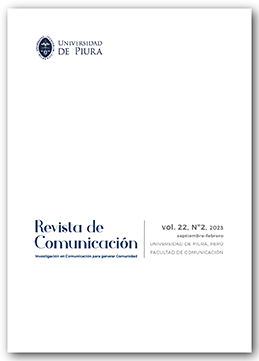Augmented screen, triple narrative, and user role: a case study
DOI:
https://doi.org/10.26441/RC22.2-2023-3239Keywords:
augmented reality, disney, short film, active receiver, technology, triple narrative, augmented screen, hybridisation, visualizationAbstract
The present panorama shows a society saturated with images, driven using mobile devices and constant audiovisual consumption. However, no greater skills are achieved in users, but on the contrary, there is evidence of a detriment in the rate of attention and the need for a differentiating product from the wide range of available content. Given this recent uncertainty, the film industry has found a great ally in technology. The existence of technologies such as augmented reality is still in its infancy and raises new questions about the potential for its use in film. In this study, we conducted a case study analysis of the first Disney augmented reality short film, Remembering (Allan-Blitz, 2022). The methodology used focuses on three approaches: audiovisual language, technological viewing and the role of the receiver. The results show the existence of a digital and economic disparity, due to the particularity of the viewing hardware. In addition, the story presents a tripartite narrative; a slower and simpler one with wide shots, a faster and more unstable one where physical and virtual spaces converge, and a last one created by the user as a steadycam. These readings require a more active and present spectator, in a story that lacks the adaptation of audiovisual language to the new form of visualisation, in which the possibilities of time and space provided by these technologies are not taken advantage of.
Metrics
References
Allan-Britz, E. (2017). Take every wave: Laird in VR. [Cortometraje]. Moxie Firecracker Films.
Allan-Britz, E. (2019). The messy truth in VR. [Miniserie]. Magic Labs Media.
Allan-Blitz, E. (2022). Remembering. [Película]. Magnopus; Disney StudioLab.
Alonso González, M. y García Orta, M. J. (2017). Televisión Digital Interactiva.
Experiencias hacia una comunicación transmedia. Ámbitos: revista internacional de comunicación, 35. https://doi.org/10.12795/ambitos.2016.i35.03 DOI: https://doi.org/10.12795/Ambitos.2016.i35.03
Alves, P. (2012). Por la democratización del cine: una perspectiva histórica sobre el cine digital. Revista ICONO 14. Revista Científica De Comunicación Y Tecnologías Emergentes, 10(1), 120-134. https://doi.org/10.7195/ri14.v10i1.139 DOI: https://doi.org/10.7195/ri14.v10i1.139
Azuma, R. T. (1997). A survey of augmented reality. Presence: teleoperators & virtual environments, 6(4), 355-385. DOI: https://doi.org/10.1162/pres.1997.6.4.355
Barrett, R., Gandhi, H. A., Naganathan, A., Daniels, D., Zhang, Y., Onwunaka, C., Luehmann, A. y White, A. D. (2018). Social and tactile mixed reality increases student engagement in undergraduate lab activities. Journal of Chemical Education, 95(10), 1755-1762. https://doi.org/10.1021/acs.jchemed.8b00212 DOI: https://doi.org/10.1021/acs.jchemed.8b00212
Brooker, C. (2011). Black Mirror. [Serie de Televisión]. Zeppotron; Channel 4.
Cabero-Almenara, J., Barroso-Osuna, J., Llorente-Cejudo, C. y Fernández Martínez, M. D. M. (2019). Educational uses of augmented reality (AR): Experiences in educational science. Sustainability, 11(18). https://doi.org/10.3390/su11184990 DOI: https://doi.org/10.3390/su11184990
Cameron, J. (2009). Avatar. [Película]. 20th Century Fox; Lightstorm Entertainment; Giant Studios Inc.
Carpenter, J. (1988). They Live. [Película]. Alive Films.
Cincera, R. (1967). Kinoautomat: a man and his house. [Película].
Favreau, J. (2010). Iron Man 2. [Película]. Paramount Pictures; Marvel Entertainment; Marvel Studios; Fairview Entertainment.
Freixa Font, P. (2009). Modelo para el découpage de audiovisuales interactivos. http://hdl.handle.net/10230/16197
Fonte, J. y Mataix, O. (2001). Walt Disney: el hombre, el mito. Biografía. T&B Editores.
Gil González, A. J. (2015). Narrativa aumentada. 1616: Anuario de literatura comparada, 5(27). http://hdl.handle.net/10366/128051
Häfner, P., Häfner, V. y Ovtcharova, J. (2013). Teaching methodology for virtual reality practical course in engineering education. Procedia Computer Science, 25, 251-260. https://doi.org/10.1016/j.procs.2013.11.031 DOI: https://doi.org/10.1016/j.procs.2013.11.031
Janin, A. L., Mizell, D. W. y Caudell, T. P. (1993, septiembre). Calibration of head-mounted displays for augmented reality applications. En Proceedings of IEEE Virtual Reality Annual International Symposium. https://doi.org/10.1109/vrais.1993.380772 DOI: https://doi.org/10.1109/VRAIS.1993.380772
Jurado-Martín, M. (2020). Aproximación a los certámenes cinematográficos de realidad virtual, aumentada e inmersiva en América Latina. Comunicación y medios, 29(42), 134-145. https://doi.org/10.5354/0719-1529.2020.56993 DOI: https://doi.org/10.5354/0719-1529.2020.56993
Kosinski, J. (2022). Top Gun: Maverick. [Película]. Paramount Pictures; Jerry Bruckheimer Films; Skydance Productions.
Lipovetsky, G. y Serroy, J. (2009). La pantalla global. Barcelona: Anagrama.
Lumière, L. y Lumière, A. (1896). L'Arrivée d'un train à La Ciotat. [Película]. Lumière.
Malik, A. J. (2018). Terminal 3 [Película]. Beagle Pug Films; LuckyChap entertainment.
Malik, A. J. (Dirección). (2019). A Jester’s Tale [Cortometraje]. 1RIC; RYOT Films.
Martínez-Cano, F. J. y Ivars-Nicolás, B. (2019). La interactividad como estrategia narrativa audiovisual: estudio de caso de Black Mirror: Bandersnatch. En J. Sierra y J.M. Lavín (Eds.), Redes sociales, tecnologías digitales y narrativas interactivas en la sociedad de la información (pp. 547-558). McGraw-Hill Interamericana de España.
Martínez-Cano, F. J., López-Agulló Pérez-Caballero, J.M. y Hernández-Martínez, E. (2022). Cine de realidad aumentada: Reformulación del aparato cinematográfico: Estudio de caso de a Jester’s Tale. Fonseca Journal of Communication, 24, 109–125. https://doi.org/10.14201/fjc.28303 DOI: https://doi.org/10.14201/fjc.28303
Milgram, P. y Kishino, F. (1994). A taxonomy of mixed reality visual displays. IEICE Transactions on Information and Systems, 77(12), 1321-1329.
Peña-Acuña, B. y Martínez-Sala, A. M. (2022). Cuentos de Realidad Aumentada para el aprendizaje de la lengua. Porta Linguarum: revista internacional de didáctica de las lenguas extranjeras, 37, 291-306. https://doi.org/10.30827/portalin.vi37.20938 DOI: https://doi.org/10.30827/portalin.vi37.20938
Rodríguez Rosell, M. D. M. y Melgarejo Moreno, I. (2010). Cine infantil: aproximación a una definición. Doxa Comunicación, 10, 167-181. https://doi.org/10.31921/doxacom.n10a8. DOI: https://doi.org/10.31921/doxacom.n10a8
Rivas Romero, M. A. (2018). Cartografía del paisaje audiovisual a comienzos del siglo XXI. Disney, un imperio mediático global. Eviterna, 3, 33-46. https://doi.org/10.24310/eviternare.v0i0.8225 DOI: https://doi.org/10.24310/Eviternare.v0i0.8225
Ruiz Torres, D. (2013). La realidad aumentada y su aplicación en el patrimonio cultural. Ediciones Trea.
Scolari, C. A. (6 de 1 de 2019). Bandersnatch. Apuntes sobre la construcción del «tele usuario».Recuperado de Hipermediaciones: https://hipermediaciones.com/2019/01/06/bandersnatch/
Slade, D. (2018). Black: Bandersnatch [Serie]. Netflix; House of Tomorrow.
Vigotsky, L. (1981). Pensamiento y lenguaje. Buenos Aires: La Pléyade
Downloads
Published
How to Cite
Issue
Section
License
Copyright (c) 2023 Revista de Comunicación

This work is licensed under a Creative Commons Attribution-NonCommercial-NoDerivatives 4.0 International License.












 Portal de Revistas de la Universidad de Piura.
Portal de Revistas de la Universidad de Piura.